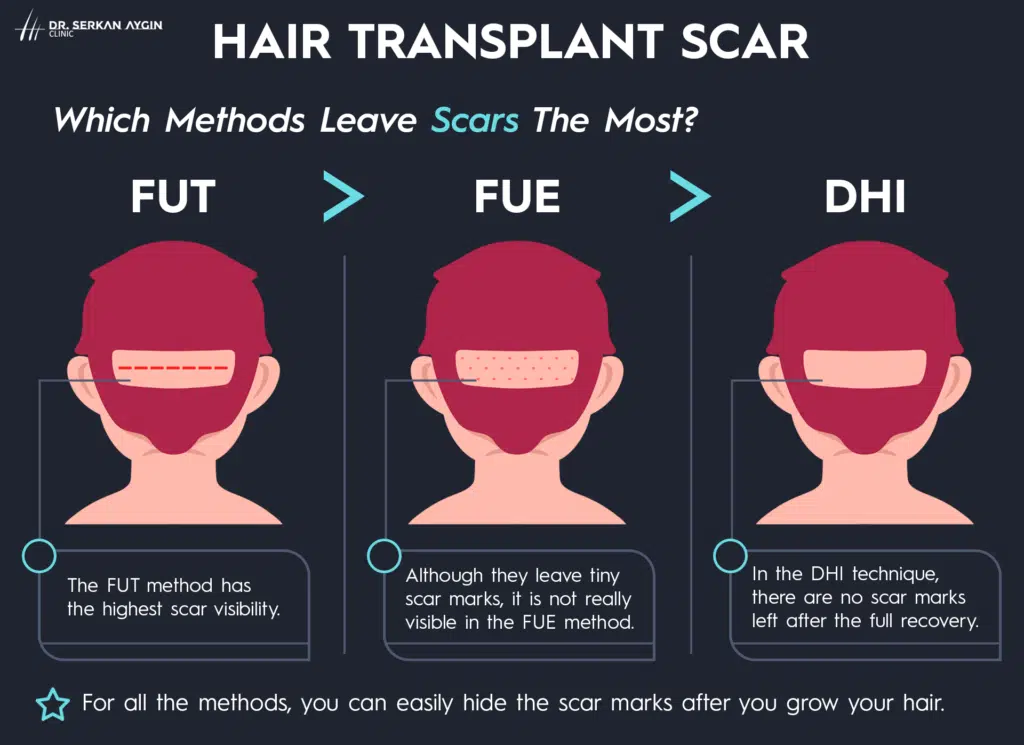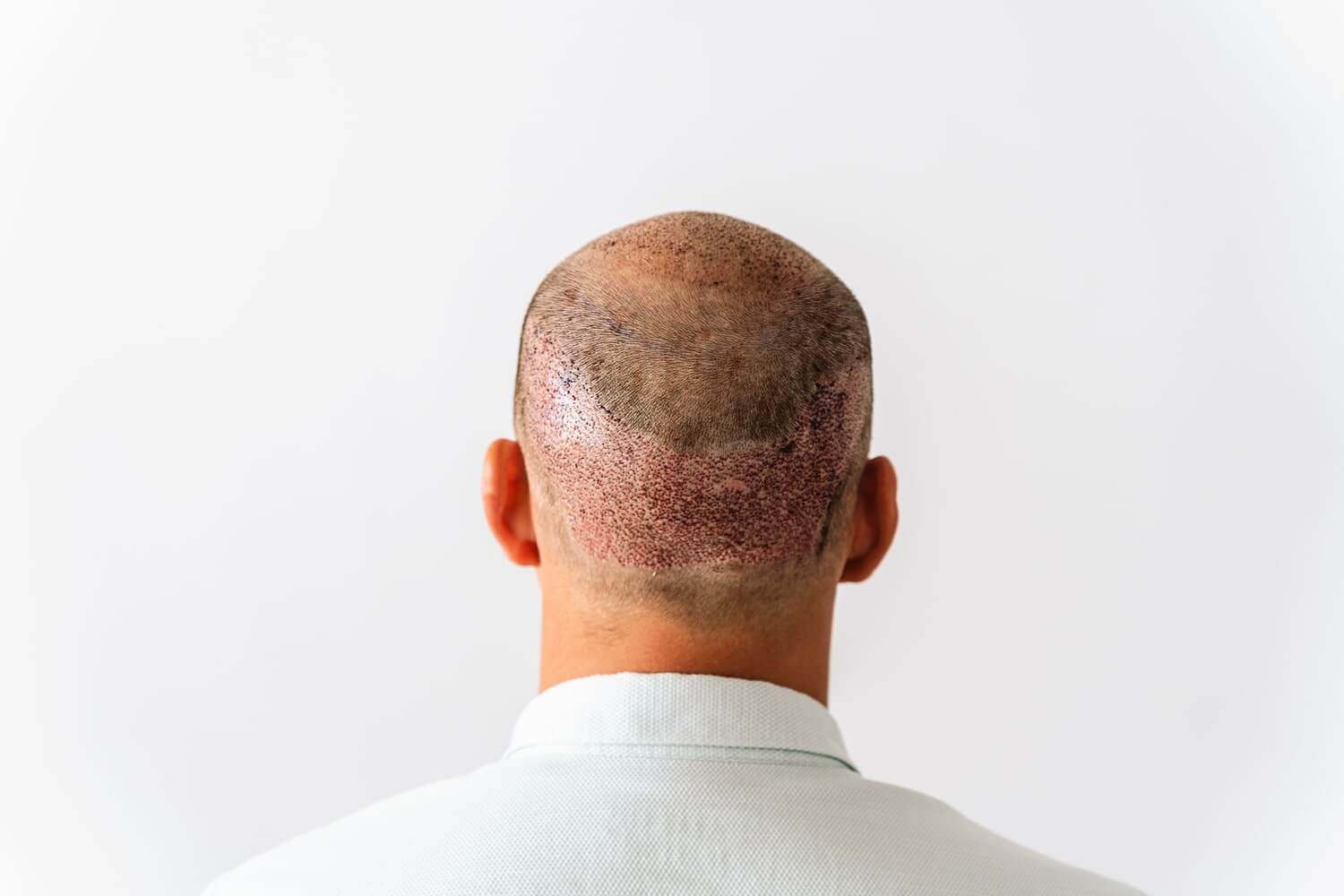Hair transplant scars refer to any traces of incisions, wounds, or marks left by the extraction and implantation process. Don’t worry, it might sound a bit scary, but in fact, it’s not as daunting as it seems.
As long as you are getting your hair transplant surgical procedure at a reputable hair restoration clinic, you will not need to worry about any kind of scar from a hair transplant.
Here are the key points that you will see in this article:
- ALL HAIR TRANSPLANT SURGERIES LEAVE SCARS BEHIND.
- FUT HAS THE BIGGEST AND MOST PROMINENT TYPES OF SCAR.
- DHI HAS THE LEAST AND MOST UNNOTICEABLE TYPES OF SCARS.
- THERE ARE SEMI-PERMANENT WAYS TO GET RID OF HAIR TRANSPLANT SCARS.
- HAIR CAN BE TRANSPLANTED IN THE SCAR TISSUE TO MAKE IT LESS VISIBLE.
- THERE ARE SMP AND TMP WHICH ARE SCALP HAIR TATTOOING TO COVER THE SCARS.
Now, to better handle a hair transplant scar, let’s dig deeper.
What To Know About Hair Transplant Scars?
Scarring after a hair transplant is an inevitable part of the surgery and a natural part of the healing process. Even if there are any surgical scars, they are easily manageable and concealable.
The type of scarring depends on the kind of hair transplant procedure which means the methods of managing the scars vary depending on the procedure you’re getting. There are three types of hair transplant procedures:
- FOLLICULAR UNIT TRANSPLANTATION (FUT)
- FOLLICULAR UNIT EXTRACTION (FUE)
- DIRECT HAIR IMPLANTATION (DHI)
What Types Of Hair Transplant Methods Leave Scars?
All hair transplant surgeries leave a type of scar on the scalp. It is just a matter of how big and visible the scar would be after the healing process.
However, not all of the methods leave similar scars behind. The most different, biggest, and deepest scars that will be left behind are from a FUT procedure. FUE and DHI leave pretty much the same scars, which are smaller than FUT.

How Does Scarring Look For FUT, FUE, and DHI?
All hair transplant surgery methods will leave scars behind. What makes it different is how these scars change during the healing process and whether or not they leave any visible marks or even turn into a keloid.
But if we want to tell you how different these scars are from each other, let us explain below briefly!
FUT Scars
FUT has the most prominent and most visible scar possible. Even in the hands of an experienced surgeon, a hair transplant linear scar is inevitable but probably more easily concealable. Some patients may experience hypertrophic scars, meaning raised and thickened surgery scars.
FUE Scars
FUE is a better option if you are not looking to have a pretty visible scar on the back of your scalp. With a FUE procedure, there will be small round scars left on your scalp due to the hair extraction but since they are small it is less likely for them to be visible and leave behind any unpleasant mark on your scalp.
DHI Scars
DHI is the latest method of hair transplant that basically does not leave any scars behind.
Why Does Scarring Occur After Hair Transplant?
Scarring happens because it is your body’s way of responding to trauma. Hair transplant surgery is a kind of trauma to the skin of your scalp. Different hair transplantation procedures cause different levels of trauma to the scalp therefore people could end up with different types of scars. Make sure to get well-informed and steer away from hair transplant scar myths.
Scarring After FUT Hair Transplant
The linear scarring after FUT is unavoidable because of the strip of skin that is taken from the back of your scalp. This is one of the reasons that has made FUT the least favorable type of hair restoration.
Scarring After FUE Hair Transplant
With the FUE procedure, you mostly are going to experience scars that are referred to as dot scars. These are the results of the small cuts that have to be made in order to extract the individual hair follicles.
Scarring After DHI Hair Transplant
The scar tissue that is created after a DHI hair transplant is pretty much the same as FUE. Since the Choi pen used in DHI is a precise and modern tool, the scars will be unnoticeable when your hair grows out.
How To Prevent Hair Transplant Scars From Happening?
If you want to avoid scars from happening, you should consider these two key factors before making a decision:
- CHOOSE A SKILLED SURGEON
- CHOOSE THE METHOD ACCORDINGLY
Choosing a skilled hair transplant surgeon for your hair transplant procedure will tremendously help the outcome. This also means your surgeon will choose the best method of hair transplantation for you. This will prevent any further complications and you will likely be left with minimal scarring.
As we mentioned, the FUT method has the worst kind of scarring, but with an experienced surgeon, you will have less to worry about. If done correctly there is less chance of keloid scars appearing after the wound is healed.
Can You Cover Scars After A Hair Transplant?
- MAKEUP
- SCALP MICROPIGMENTATION
- TRICOPIGMENTATION
- GROW HAIR
One of the cheapest and most easy access options is makeup. You can use hair fillers that cover your scalp. The hair filler will give your scalp and hair a fuller look and make the scars less visible.
SMP or scalp micropigmentation is a great way to cover up a scar especially the linear scar left from a FUT procedure. This way also works well for FUE and DHI scars. It is a more permanent way of covering up hair transplant scars. You could go for touch-ups every 4 to 6 years.
On the other hand, there is tricopigmentation, which works the same as SMP but it is less permanent and lasts 6 to 8 months.
Your hair can be the best cover-up! Simply go with haircuts and hairstyles that cover the back of your scalp to cover your scar. In other cases letting your hair grow out can also help with the covering of your scalp.
Will The Scars Disappear Completely?
Unfortunately no. Your skin will not go back to the state that it was in before the trauma. Even with the best scar removal technology the skin will not be the same as the unscarred skin. However, minimizing hair transplant scar visibility can be reduced through techniques such as scalp micropigmentation.
What To Do If You Can't Cover It: Hair Transplant Scar Removal
If none of the methods of covering up the visible scarring works, the most effective one that has shown promising results is laser scar removal. But before going to the closest laser hair removal place to deal with your scar, there are things you should know.
- HAVE A CONSULTATION WITH YOUR DOCTOR FIRST.
- MAKE SURE YOUR WOUND IS COMPLETELY HEALED.
- HAVE REAL EXPECTATIONS. YOUR SKIN IS NOT GOING TO LOOK LIKE IT DID BEFORE THE SURGERY.
- LASER TREATMENT CAN ONLY REDUCE YOUR SCAR LOOK BY REMOVING THE TOP LAYER OF THE SCAR AND TRIGGERING COLLAGEN-MAKING.
Hair Scar Repair
With hair scar repair, the doctor will implant healthy hair follicles in the scar tissue. Scar tissue does not have any blood supply so the doctor needs to be extra careful with the donor hair.
If the implantation goes well the results will be permanent and the hair transplant scar will not be visible anymore.
REFERENCES
Konior RJ. Complications in hair-restoration surgery. Facial Plast Surg Clin North Am. 2013 Aug;21(3):505-20. doi: 10.1016/j.fsc.2013.05.012. PMID: 24017992.
Alhamzawi NK. Keloid Scars Arising after Follicular Unit Extraction Hair Transplantation. J Cutan Aesthet Surg. 2020 Jul-Sep;13(3):237-239. doi: 10.4103/JCAS.JCAS_181_19. PMID: 33209003; PMCID: PMC7646428.
Oliaei S, Nelson JS, Fitzpatrick R, Wong BJ. Laser treatment of scars. Facial Plast Surg. 2012 Oct;28(5):518-24. doi: 10.1055/s-0032-1325646. Epub 2012 Oct 1. PMID: 23027219.

